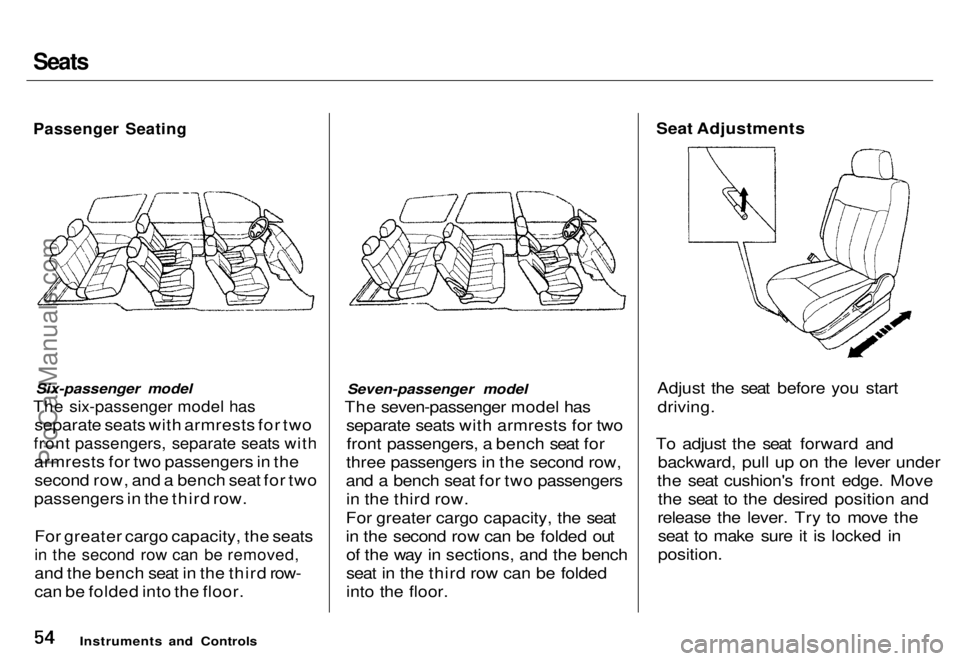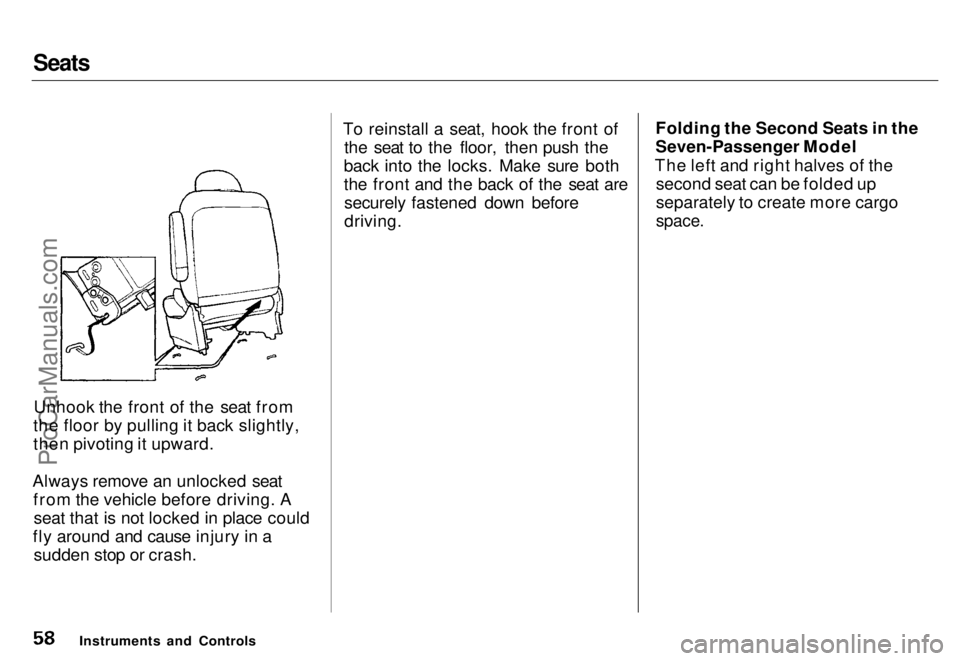1996 HONDA ODYSSEY fold seats
[x] Cancel search: fold seatsPage 6 of 240

The Seat Belt System and How It Works
Why Wear Seat Belts
Wearing seat belts, and wearing them properly, is fundamental to
your safety and the safety of your
passengers.
During a crash or emergency stop,seat belts can help keep you from
being thrown against the inside of
the car, against other occupants, or out of the car.
Of course, seat belts cannot com-
pletely protect you in every crash. But, in most cases, seat belts reduce
your chance of serious injury. They can even save your life. That is whymany states and all Canadian pro-
vinces require you to wear seat belts. Important Safety Reminders
Seat belts are designed for adults
and larger children. All infants and small children must be properly
restrained in child safety seats (see
page 20 ).
Never let passengers ride in the
cargo area or on top of a folded-downseat. Carry passengers in the rear
only when they are sitting in a locked,
upright seat, and are properly restrained by seat belts. Passengers should not stand up or
change seats while the vehicle is moving. If they are not wearing seat
belts during a crash or emergency stop, they can be thrown against the
inside of the vehicle, against other occupants, or out of the vehicle.
A pregnant woman needs to wear a seat belt to protect herself and her
unborn child (see page 10 ).
Two people should never use the same seat belt. If they do, they could
be very seriously injured in a crash.
Do not place the shoulder portion of a lap/shoulder belt under your arm
or behind your back. This could
increase the chance of serious
injuries in a crash.
Do not put shoulder belt pads or
other accessories on seat belts. They
can reduce the effectiveness of the
belts and increase the chance of
injury.
Driver and Passenger Safety
Not wearing a seat belt
increases the chance of being
killed or seriously hurt in a
crash.
Be sure you and your
passengers always wear seat
belts and wear them properly.ProCarManuals.comMain Menu s t Table of Contents
Page 32 of 240

Instruments and Controls
This section gives information about the controls and displays thatcontribute to the daily operation of
your Honda. All the essential controls are within easy reach.
Control Locations............................ 32
Indicator Lights................................ 33
Gauges.............................................. 37
Speedometer................................ 37
Trip Meter.................................... 37
Odometer......................................
37
Temperature Gauge................... .
38
Fuel Gauge.................................. 38
Maintenanc
e Required
Indicator...................................
38
Controls Nea r
the Steering
Wheel........................................ 39
Headlights.................................... 40
Daytime Running Lights............. 40
Instrument Panel Brightness..... 41
Turn Signals................................. 41
Windshield Wipers...................... 42
Windshield Washers................... 42 Rear Window Wiper and Washer...................................... 43
Hazard Warning........................... 43
Rear Window Defogger.............. 43
Steering Wheel Adjustment....... 44
Steering Wheel Controls................ 46 Cruise Control.............................. 46
Keys and Locks................................ 49
Keys............................................... 49
Ignition Switch............................. 49
Power Door Locks....................... 50
Remote Transmitter.................... 51Childproof Door Locks............... 52
Tailgate......................................... 52
Glove Box..................................... 53
Seats.................................................. 54
Passenger Seating....................... 54
Seat Adjustments......................... 54
Driver's Seat Power Height Adjustment............................... 55
Head Restraints........................... 56 Third Seat Access........................ 56
Removing the Second Seats in the Six-Passenger Model.... 57
Folding the Second Seats in the Seven-Passenger
Model....................................
58
Reclining th e
Second Seat.......... 59
Folding the Third Seat
in All Models............................ 60
Power Windows............................... 62
Sunroof.............................................. 63
Mirrors.............................................. 64
Adjusting the Power Mirrors..... 64
Parking Brake..................................
65
Digital Clock.................................... .
66
Beverage Holder.............................. 66
Dashboard Compartment............... 68 Center Pocket.................................. 68
Vanity Mirror................................... 68 Cigarette Lighter............................. 69
Ashtrays............................................ 69 Interior Lights.................................. 70
Ceiling Lights............................... 70
Spotlights...................................... 70
Tailgate Light............................... 71 Courtesy Lights........................... 71
Instruments and ControlsProCarManuals.comMain Menu s t
Page 55 of 240

Seats
Passenger Seating
Six-passenger model
The six-passenger model has
separate seats with armrests for two
front passengers, separate seats with
armrests for two passengers in thesecond row, and a bench seat for two
passengers in the third row.
For greater cargo capacity, the seats
in the second row can be removed,
and the bench seat in the third row-
can be folded into the floor. Seven-passenger model
The seven-passenger model has separate seats with armrests for twofront passengers, a bench seat for
three passengers in the second row,
and a bench seat for two passengers in the third row.
For greater cargo capacity, the seat
in the second row can be folded out of the way in sections, and the bench
seat in the third row can be folded
into the floor.
Seat Adjustments
Adjust the seat before you startdriving.
To adjust the seat forward and backward, pull up on the lever under
the seat cushion's front edge. Move the seat to the desired position and
release the lever. Try to move the seat to make sure it is locked in
position.
Instruments and ControlsProCarManuals.comMain Menu s t Table of Contents
Page 59 of 240

Seats
Unhook the front of the seat from
the floor by pulling it back slightly,
then pivoting it upward.
Always remove an unlocked seat from the vehicle before driving. Aseat that is not locked in place could
fly around and cause injury in a sudden stop or crash. To reinstall a seat, hook the front of
the seat to the floor, then push the
back into the locks. Make sure both
the front and the back of the seat are securely fastened down before
driving. Folding the Second Seats in the
Seven-Passenger Model
The left and right halves of the second seat can be folded up
separately to create more cargo
space.
Instruments and ControlsProCarManuals.comMain Menu s t Table of Contents
Page 61 of 240

Seats
ANGLE ADJUSTMENT LEVER
SLIDE LEVER
2. Lift the lever and slide the seat forward as far as it will go. Pull the
seat-back angle adjustment lever
and pivot the seat-back backward.
Release the lever when the seat-
back is even with the cushion on
the third seat.
Reverse this procedure to return the
second seat to the upright position.
Make sure you install the head
restraints before driving (see page 56). Folding the Third Seat in All
Models
To create more cargo space, you can
fold the third seat into the floor
recess.
To fold the third seat:
1. Remove the head restraints. Store them in the pocket in the left side
panel.
KNOB
2. Unlock the seat-back by turning the knob. Push the seat-back
forward.
Instruments and ControlsProCarManuals.coms t Main Menu Table of Contents
Page 116 of 240

Loading Cargo
The maximum load you can carry in your Honda is 535 kg (1,150 Ibs). It includes the total weight of all
passengers and their belongings, anyaccessories, and the tongue weight
figure is shown as the Vehicle Capacity Weight on the tire infor-
mation label attached to the driver's doorjamb. To figure out how much cargo you
can carry:
Figure the total "occupant weight"
you will be transporting. To. do this. (driver and all passengers) by 70
kg
(150 Ibs).
Subtract this number from the
Vehicle Capacity Weight (535 kg/ 1,150 Ibs).
If you are towing a trailer, subtract
the tongue weight. See Towing a
Trailer on page 128.
This final number is the total weight of cargo you can load in or on the car.
With seven occupants (driver and six passengers), the maximum recom-
mended weight for cargo is 45 kg (100 Ibs).
Where you store this cargo, and how
well you secure it, are just as important as how much it weighs.Make sure you load cargo so it will not shift while driving. Items stored
in the cargo area behind the third
seat should be placed as far forward
as possible. You could store addi-
tional items on the floor behind the
roll under the front seat and
interfere with the pedals.
For greater cargo capacity, the third seat can be folded into the floor and
the second row seats can either be
removed or folded up (depending on
model). Passengers should never sit in the open cargo area while the car
is moving. They should sit in one of
the seats and wear their seat belts.
If you must carry large objects that
prevent you from closing the tailgate
be aware that exhaust gas can enter
the interior. See Carbon Monoxide
Hazard on page 29 .
Before DrivingProCarManuals.comMain Menu s t Table of Contents
Page 235 of 240

Index
Fluids
Automatic Transmission........... 155
Brake........................................... 156
Power Steering........................... 157
Windshield Washer................... 154
FM Stereo Radio
Reception.................................... 97
Folding the Second Seats ............... 58
Folding the Third Seats.................. 60
Foreign Countries, Driving in...... 109
Four-way Flashers......................... 43
Front End, Towing by Emergency
Wrecker.................................... 213
Fuel.................................................. 108
Fill Door and Cap....................... 110
Gauge.......................................... 38
Octane Requirement................. 108
Oxygenated................................ 108
Tank, Filling the......................... 110
Fuses, Checking the...................... 209
Gas Mileage, Improving................ 114
Gasohol........................................... 108
Gasoline.......................................... 108
Gauge.......................................... 38
Octane Requirement................. 108
Tank, Filling the......................... 110
Gas Station Procedures................. 110
Gauges Engine Coolant Temperature .... 38
Fuel.............................................. 38
Gearshift Lever Positions............. 120 Glass Cleaning............................... 187
Glove Box......................................... 53
Halogen Headlight Bulbs.............. 177
Hazard Warning Flashers............. 43
Headlights....................................... 40
Aiming......................................... 175Daytime Running Lights............. 40
High Beam Indicator................... 36High Beams, Turning on............ 40
Low Beams, Turning on............. 40
Reminder Chime.......................... 40 Replacing Halogen Bulbs ......... 177
Turning on.................................. 40
Head Restraints............................... 56
Heating and Cooling........................ 74 High Altitude, Starting at............ 119
High-Low Beam Switch............... 40
Hood, Opening the ...................... 111
Horn............................................... 39
Hot Coolant, Warning about...... 151 Hydroplaning................................ 127
Identification Number, Vehicle.. 216
If Your Car Has to be Towed..... 213Ignition
Keys............................................. 49
Switch.......................................... 49
Timing Control System............. 225
Indicator Lights, Instrument
Panel............................................. 33
Infant Restraint............................... 22 Inflation, Proper Tire .................... 170
Inside Mirror................................... 64
Inspection, Tire.............................. 171
Instrument Panel............................. 33
Instrument Panel Brightness........ 41
Interior Cleaning............................ 186
Interior Lights................................. 70
Introduction...................................... iProCarManuals.comMain Menu s t
Page 237 of 240

Index
Outside Mirrors............................... 64
Overheating, Engine..................... 202
Panel Brightness Control............... 41
Park Gear Position......................... 121
Parking Brake.................................. 65
Parking Lights.................................. 40
Parking Over Things that Burn... 226
PGM-FI System.............................. 225
Polishing and Waxing................... 184
Power
Door Locks................................... 50
Mirrors.......................................... 64
Steering....................................... 157
Windows....................................... 62
Pregnancy, Using Seat Belts.......... 10
Proper Seat Belt Usage..................... 7
Radiator Overheating.................... 202
Radio/Cassette Sound System....... 83
Rear A/C Unit.................................. 82
Rear End Towing........................... 213 Rear Lights, Bulb Replacement... 179
Rear View Mirror............................. 64
Rear Window Defogger.................. 43
Rear Window Wiper and Washer.. 43
Reclining the Seat Backs................ 55
Reclining the Second Seats............ 59
Reminder Lights.............................. 33
Remote Transmitter........................ 51
Removing the Second Seats........... 57
Replacement Information Air Cleaner................................. 158Coolant........................................ 152
Engine Oil and Filter................. 148
Fuses........................................... 209
Light Bulbs................................. 177
Schedule..................................... 138
Spark Plugs................................. 160
Tires............................................ 172
Wiper Blades.............................. 165
Replacing Seat Belts After a
Crash............................................. 11
Reserve Tank, Coolant.................. 150
Restraint, Child................................ 20
Reverse Gear Position................... 121
Rotation, Tire................................. 172
Safety Belts....................................... 5
Safety Defects, Reporting*.......... 232
Safety Labels, Location of............. 30
Safely Messages .............................. ii
Seat Belts ......................................... 5
Advice for Pregnant Women...... 10Cleaning...................................... 187
Frayed or Torn............................ 11
Maintenance............................... 11
Reminder Light and Beeper....... 34
Replacement................................ 11
System Components.................... 6
Tether Attachment Points........ 26 Use During Pregnancy................ 10
Wearing a Lap/Shoulder Belt..... 7
Wearing the Lap Belt................... 9
Seats................................................. 54
Adjustments ................................ 54
Driver's Seat Power
Height Adjustment................
55
Folding th e
Second Seats..........
58
Folding th
e
Third Seats............ 60
Head Restraints .......................... 56
Passenger Seating......................
54
ProCarManuals.comMain Menu s t